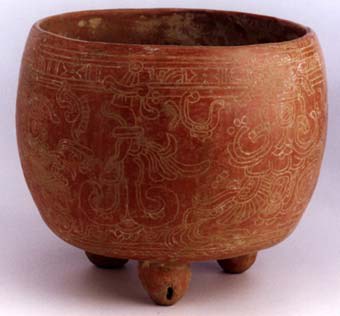Mayan Tripod Vessel, 6th Century CE - 9th Century CE
Terracotta
5.25
PF.3440
The Maya in their great temple cities reached the summit of the classical age in Ancient Meso-America. In those temple cities, great artistic expressions such as murals and sculptures flourished....
The Maya in their great temple cities reached the summit of the classical age in Ancient Meso-America. In those temple cities, great artistic expressions such as murals and sculptures flourished. It is during this classical period in which artists refined their skills to represent the human forms, deities and other symbolic pottery. Used in various rituals and ceremonies, their art embodied rich symbolism, laden with complex meanings, which largely remain esoteric. This beautiful vessel in warm orange color depicts complex Mayan symbols in a very intricate fashion. Incised with thin lines, the top of the vessel indicated a sky band divided in to compartments in vertical bars. Each compartment is filled with various symbols for stars or planets. Beneath the sky band is an elaborate portrayal of the mythical creatures—
the water-Lilly monster and the serpents. The water-Lilly monster is elaborately decorated, placed on the band of water. The water-Lilly monster is the symbol of standing bodies of water, such as the ocean, lakes, swamps, and agricultural canals. Because water-Lilly were abundant in the canals used by the Maya, they became the symbol of the earth's abundance. Moreover, the beaded representation of blood stream is depicted inside the serpents' body and the blood scroll is portrayed at their tail. Beautifully rendered, this Mayan vessel contains complex religious and ritualistic significance. Although we may not be able to decipher the detailed meaning of the symbols, we are amazed at the complicated Mayan art and its glyphic system. The more we look at the vessel, the more fascinating it is to try to imagine what the myriad of signs symbolizes.
the water-Lilly monster and the serpents. The water-Lilly monster is elaborately decorated, placed on the band of water. The water-Lilly monster is the symbol of standing bodies of water, such as the ocean, lakes, swamps, and agricultural canals. Because water-Lilly were abundant in the canals used by the Maya, they became the symbol of the earth's abundance. Moreover, the beaded representation of blood stream is depicted inside the serpents' body and the blood scroll is portrayed at their tail. Beautifully rendered, this Mayan vessel contains complex religious and ritualistic significance. Although we may not be able to decipher the detailed meaning of the symbols, we are amazed at the complicated Mayan art and its glyphic system. The more we look at the vessel, the more fascinating it is to try to imagine what the myriad of signs symbolizes.



